Abstract
Swiss albino mice inoculated i.c. with dengue type 2 virus (DV) show presence of a factor in the spleen which is cytotoxic to the normal mice spleen cells in vitro. The cytotoxic factor is present in the homogenate as well as in the culture supernatants of the spleen cells. Maximum cytotoxic activity is present in the spleen of moribund mice on 10-11 p.i. day. No cytotoxic activity was found in the homogenates of brain, liver, heart and skeletal muscles. Sera from a few mice only had cytotoxic activity and were not complement-dependent. Cytotoxic activity in the homogenate and culture supernatant (TCF) of various spleen cell populations was screened. Cytotoxicity of glass-non-adherent cells was significantly higher. DV-infected spleen cells, depleted of macrophages by carbonyl iron treatment, had higher cytotoxic activity. B-cell-enriched fractions and the glass-adherent cells had negligible cytotoxic activity. Purified lymphocytes and the T-lymphocyte-enriched fractions had maximum cytotoxicity. Thus, a cytotoxic factor is produced by T lymphocytes of the spleen of DV-infected mice which kills normal mouse spleen cells in vitro.
Full text
PDF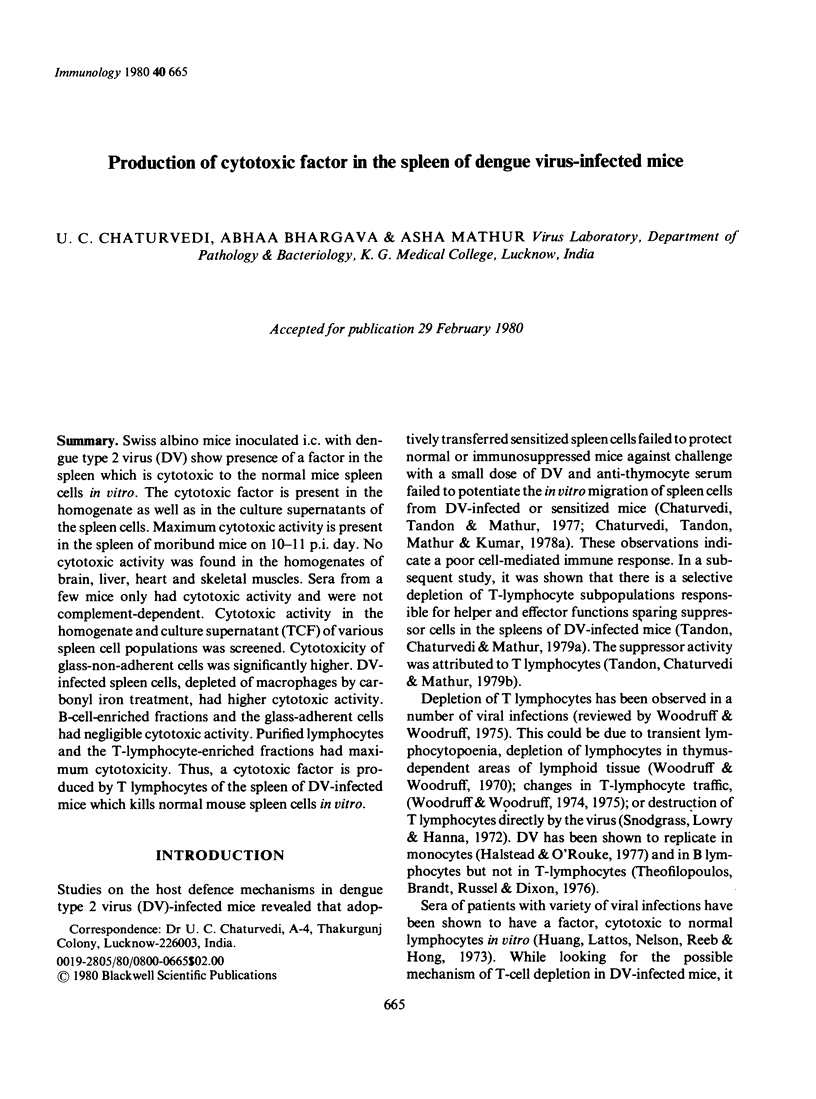
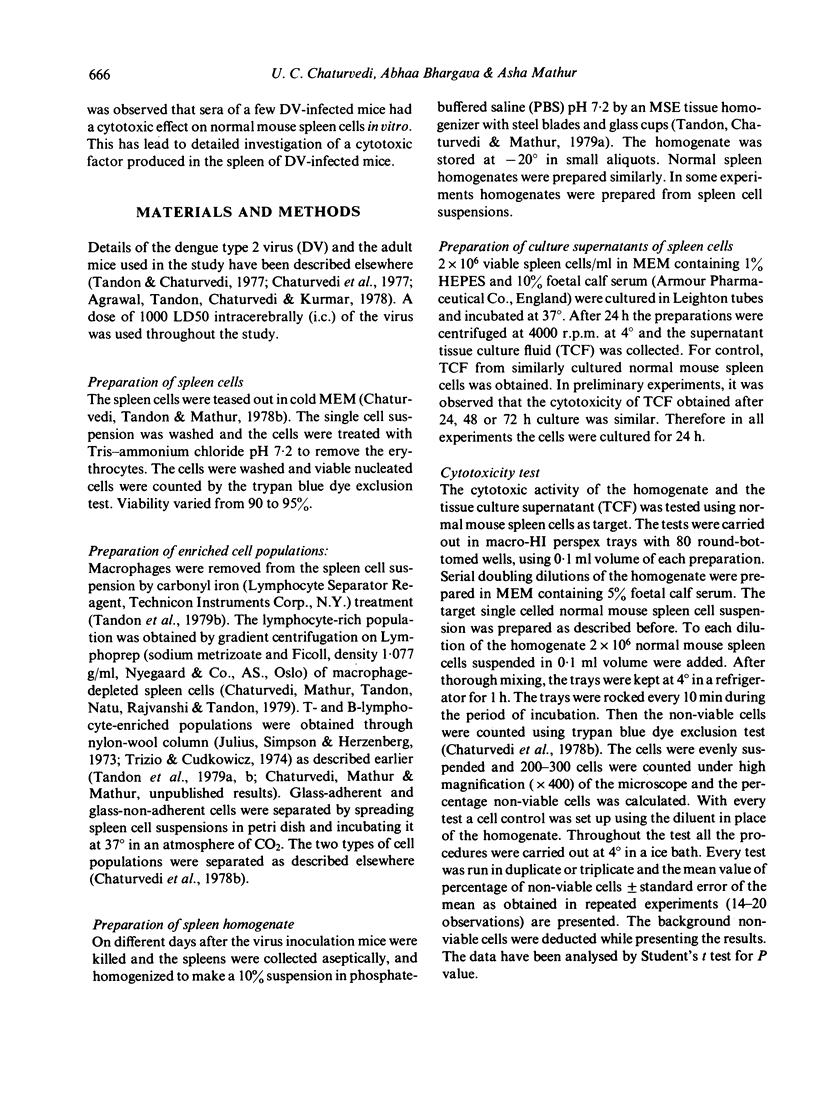
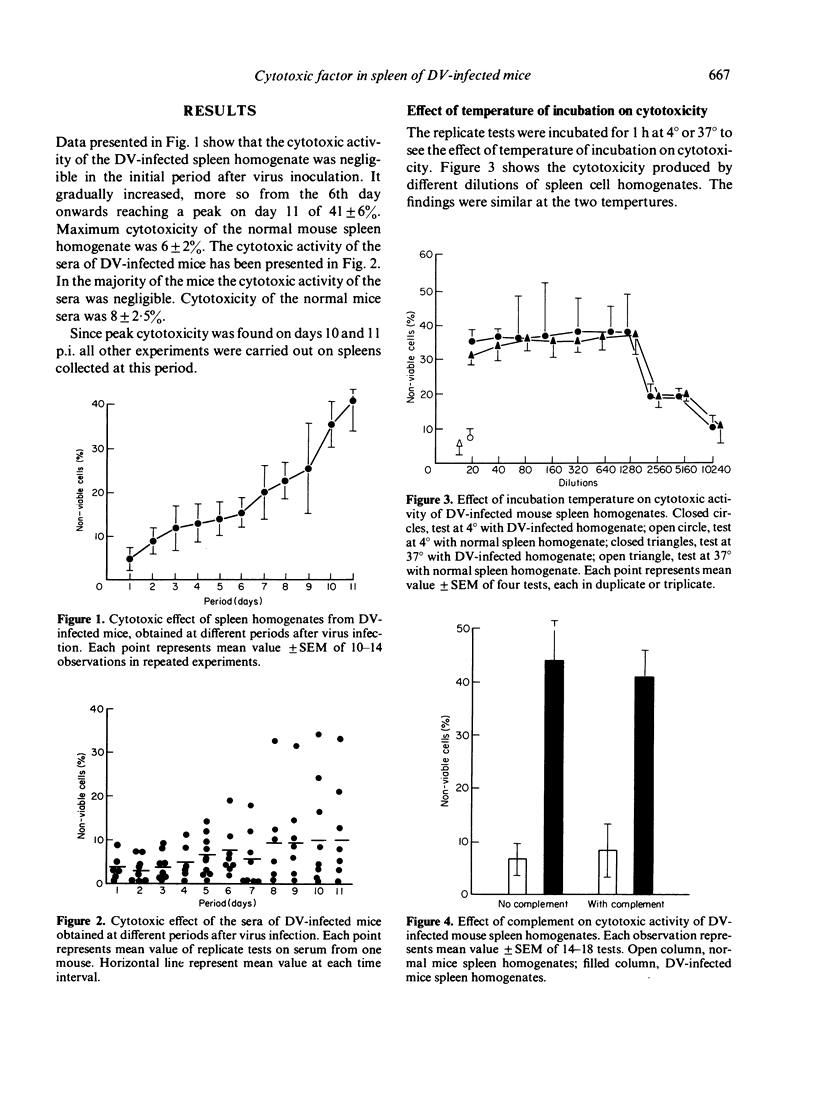
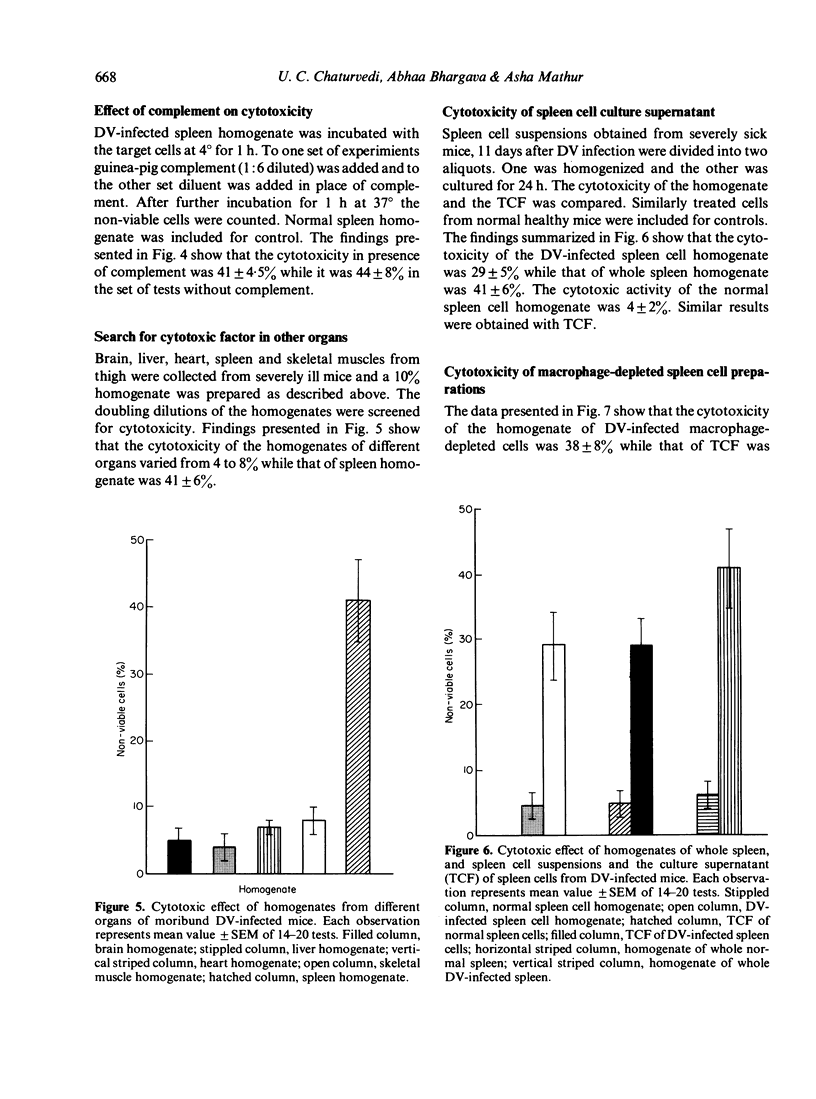

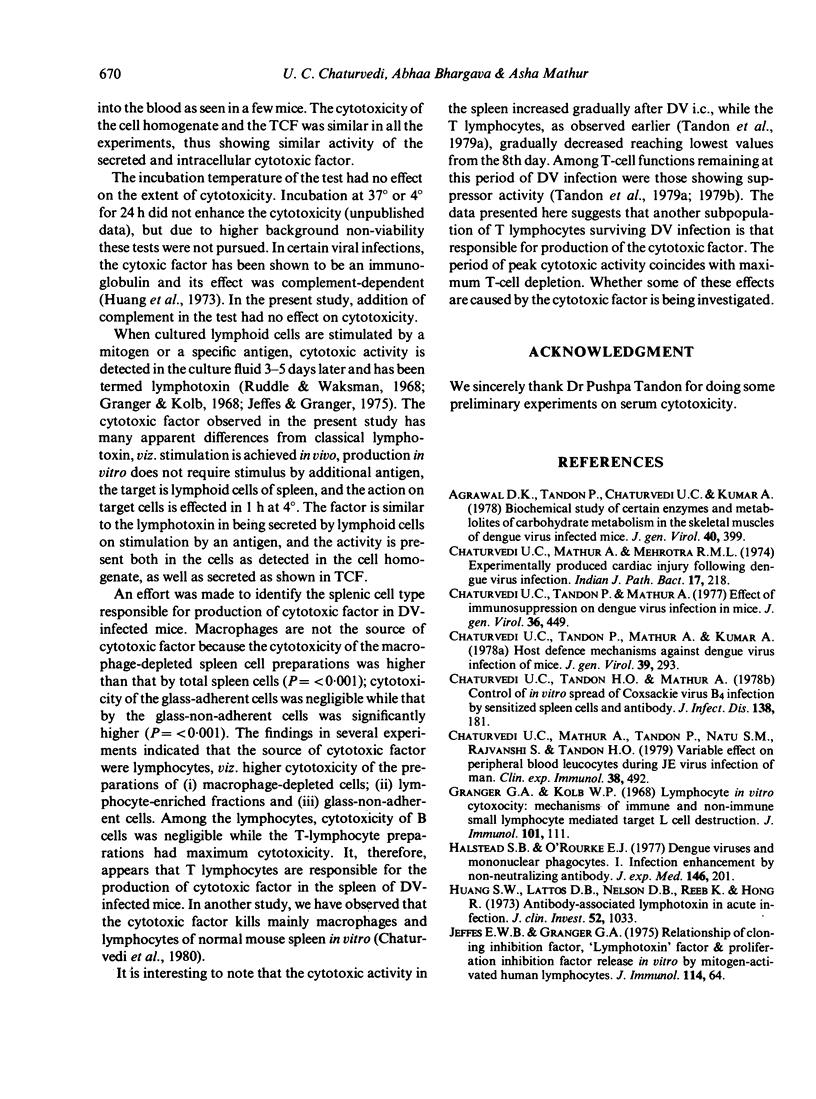
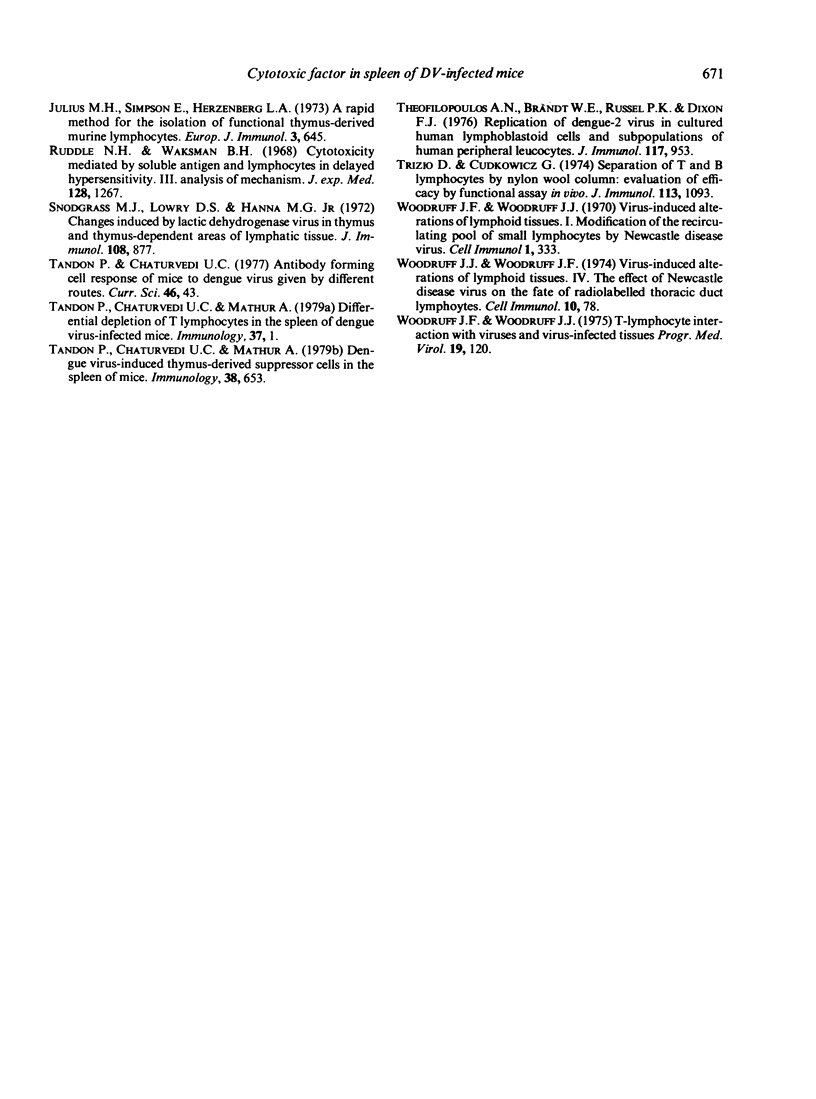
Selected References
These references are in PubMed. This may not be the complete list of references from this article.
- Agrawal D. K., Tandon P., Chaturvedi U. C., Kumar A. Biochemical study of certain enzymes and metabolites of the carbohydrate metabolism in the skeletal muscle of the dengue virus-infected mice. J Gen Virol. 1978 Aug;40(2):399–408. doi: 10.1099/0022-1317-40-2-399. [DOI] [PubMed] [Google Scholar]
- Chaturvedi U. C., Mathur A., Mehrotra R. M. Experimentally produced cardiac injury following dengue virus infection. Indian J Pathol Bacteriol. 1974 Oct;17(4):218–220. [PubMed] [Google Scholar]
- Chaturvedi U. C., Mathur A., Tandon P., Natu S. M., Rajvanshi S., Tandon H. O. Variable effect on peripheral blood leucocytes during JE virus infection of man. Clin Exp Immunol. 1979 Dec;38(3):492–498. [PMC free article] [PubMed] [Google Scholar]
- Chaturvedi U. C., Tandon H. O., Mathur A. Control of in vitro and in vivo spread of coxsackievirus B4 infection by sensitized spleen cells and antibody. J Infect Dis. 1978 Aug;138(2):181–190. doi: 10.1093/infdis/138.2.181. [DOI] [PubMed] [Google Scholar]
- Chaturvedi U. C., Tandon P., Mathur A. Effect of immunosuppression on dengue virus infection in mice. J Gen Virol. 1977 Sep;36(3):449–458. doi: 10.1099/0022-1317-36-3-449. [DOI] [PubMed] [Google Scholar]
- Chaturvedi U. C., Tandon P., Mathur A., Kumar A. Host defence mechanisms against dengue virus infection of mice. J Gen Virol. 1978 May;39(2):293–302. doi: 10.1099/0022-1317-39-2-293. [DOI] [PubMed] [Google Scholar]
- Granger G. A., Kolb W. P. Lymphocyte in vitro cytotoxicity: mechanisms of immune and non-immune small lymphocyte mediated target L cell destruction. J Immunol. 1968 Jul;101(1):111–120. [PubMed] [Google Scholar]
- Halstead S. B., O'Rourke E. J. Dengue viruses and mononuclear phagocytes. I. Infection enhancement by non-neutralizing antibody. J Exp Med. 1977 Jul 1;146(1):201–217. doi: 10.1084/jem.146.1.201. [DOI] [PMC free article] [PubMed] [Google Scholar]
- Huang S. W., Lattos D. B., Nelson D. B., Reeb K., Hong R. Antibody-associated lymphotoxin in acute infection. J Clin Invest. 1973 May;52(5):1033–1040. doi: 10.1172/JCI107268. [DOI] [PMC free article] [PubMed] [Google Scholar]
- Jeffes E. W., Granger G. A. Relationship of cloning inhibition factor, "lymphotoxin" factor, and proliferation inhibition factor release in vitro by mitogen-activated human lymphoctes. J Immunol. 1975 Jan;114(1 Pt 1):64–69. [PubMed] [Google Scholar]
- Julius M. H., Simpson E., Herzenberg L. A. A rapid method for the isolation of functional thymus-derived murine lymphocytes. Eur J Immunol. 1973 Oct;3(10):645–649. doi: 10.1002/eji.1830031011. [DOI] [PubMed] [Google Scholar]
- Ruddle N. H., Waksman B. H. Cytotoxicity mediated by soluble antigen and lymphocytes in delayed hypersensitivity. 3. Analysis of mechanism. J Exp Med. 1968 Dec 1;128(6):1267–1279. doi: 10.1084/jem.128.6.1267. [DOI] [PMC free article] [PubMed] [Google Scholar]
- Snodgrass M. J., Lowrey D. S., Hanna M. G., Jr Changes induced by lactic dehydrogenase virus in thymus and thymus-dependent areas of lymphatic tissue. J Immunol. 1972 Apr;108(4):877–892. [PubMed] [Google Scholar]
- Tandon P., Chaturvedi U. C., Mathur A. Dengue virus-induced thymus-derived suppressor cells in the spleen of mice. Immunology. 1979 Dec;38(4):653–658. [PMC free article] [PubMed] [Google Scholar]
- Theofilopoulos A. N., Brandt W. E., Russell P. K., Dixon F. T. Replication of dengue-2 virus in cultured human lymphoblastoid cells and subpopulations of human peripheral leukocytes. J Immunol. 1976 Sep;117(3):953–961. [PubMed] [Google Scholar]
- Trizio D., Cudkowicz G. Separation of T and B lymphocytes by nylon wool columns: evaluation of efficacy by functional assays in vivo. J Immunol. 1974 Oct;113(4):1093–1097. [PubMed] [Google Scholar]
- Woodruff J. F., Woodruff J. J. Virus-induced alterations of lymphoid tissues. I. Modification of the recirculating pool of small lymphocytes by Newcastle disease virus. Cell Immunol. 1970 Sep;1(3):333–354. doi: 10.1016/0008-8749(70)90053-5. [DOI] [PubMed] [Google Scholar]


